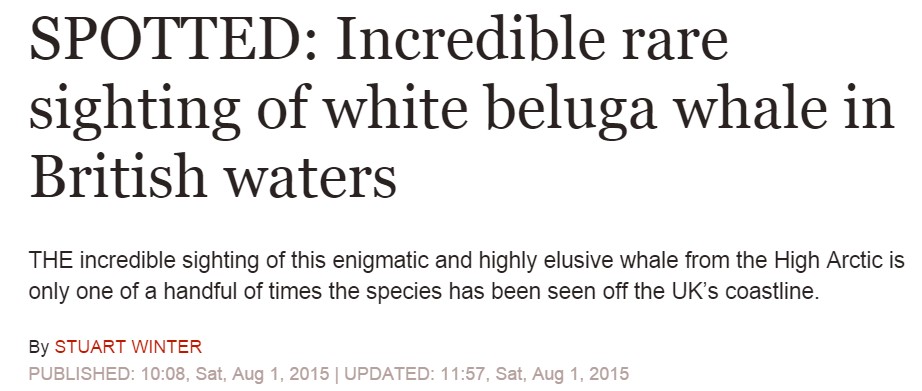By rights, the beluga should have been 2,000 miles to the north in the Barents Sea. Thousands of belugas live among the ice floes that litter the area east of the Svalbard archipelago, but only on extremely rare occasions do they swim as far south as the British Isles.
h/t Martin



“Whether the same has occurred in the case of this beluga is not clear but sea temperatures have been unusually low this summer.”
the previous paragraph is telling latitude.
He said: “This is not the first Arctic species to occur in Britain this year.
“Back in February, the first European sighting of a bowhead whale was captured on a smartphone in the Isles of Scilly.
“In that instance, it was thought that the fragmentation of floating ice may have resulted in whales typically associated with pack ice, straying much further south.
“Whether the same has occurred in the case of this beluga is not clear but sea temperatures have been unusually low this summer.”
so animals that like pack ice head south away from it when it breaks up ? i would have thought they would have headed further north, back to the pack ice edge ? of course that would not fit with the cagw narrative. the atlantic is cooling, and it looks like it will be cooling for several years to come.it will be interesting to see what nonsense is used in the explanation of this by the climate “science” community.
AMO starting to shift to negative phase is the probable direct cause,
http://stateoftheocean.osmc.noaa.gov/atm/images/amo_short.gif
The longer series puts it in perspective,
http://stateoftheocean.osmc.noaa.gov/atm/images/amo_long.gif
Maybe it’s on vacation to the beluga equivalent of Florida.
A new paper shows Earth’s surface temperatures from 1955 to 2010 correlated with the number of sunspots:
http://www.nonlin-processes-geophys-discuss.net/2/1275/2015/npgd-2-1275-2015.pdf
Sunspots – which occur when deep-seated magnetic fields from near the solar core protrude through the photosphere [1] – are unusually low in frequency now.
The magnetic fields that carry H+ ions up from the deep interior, may also accelerate protons to energies high enough to induce the CNO cycle at the top of the photosphere [2], thus heating the chromosphere.
1. “Super-fluidity in the solar interior: Implications for solar eruptions and climate,” Journal of Fusion Energy 21, 193-198 (2002). http://www.springerlink.com/content/r2352635vv166363/ http://arxiv.org/pdf/astro-ph/0501441 http://www.omatumr.com/abstracts2003/jfe-superfluidity.pdf
2. “Observational confirmation of the Sun’s CNO cycle,” J. Fusion Energy (2006)
http://link.springer.com/article/10.1007%2Fs10894-006-9003-z
Pressure anomalies over the Northern Polar Circle. The obvious effect of high cosmic radiation.
http://www.cpc.ncep.noaa.gov/products/stratosphere/strat-trop/gif_files/time_pres_HGT_ANOM_JAS_NH_2015.gif
http://oi58.tinypic.com/vyqkjk.jpg